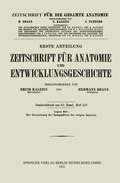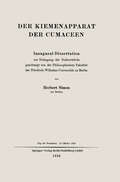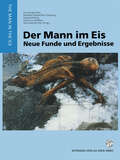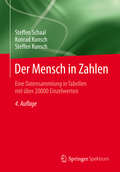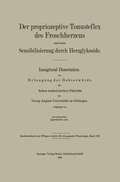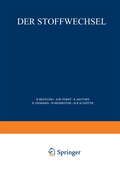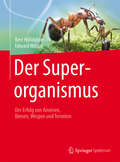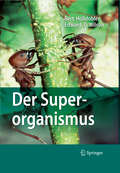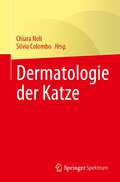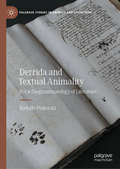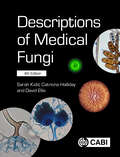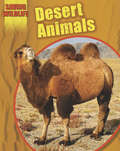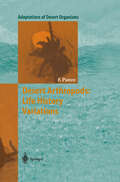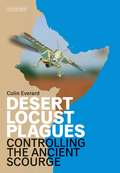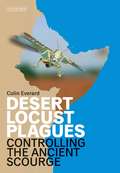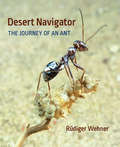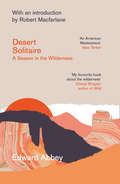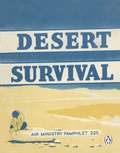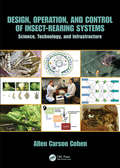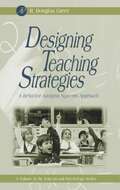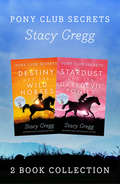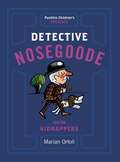- Table View
- List View
Der Grenzstrang des Sympathicus bei einigen Sauriern
by August HirtDieser Buchtitel ist Teil des Digitalisierungsprojekts Springer Book Archives mit Publikationen, die seit den Anfängen des Verlags von 1842 erschienen sind. Der Verlag stellt mit diesem Archiv Quellen für die historische wie auch die disziplingeschichtliche Forschung zur Verfügung, die jeweils im historischen Kontext betrachtet werden müssen. Dieser Titel erschien in der Zeit vor 1945 und wird daher in seiner zeittypischen politisch-ideologischen Ausrichtung vom Verlag nicht beworben.
Der Kiemenapparat der Cumaceen: Inaugural-Dissertation
by Herbert SimonDieser Buchtitel ist Teil des Digitalisierungsprojekts Springer Book Archives mit Publikationen, die seit den Anfängen des Verlags von 1842 erschienen sind. Der Verlag stellt mit diesem Archiv Quellen für die historische wie auch die disziplingeschichtliche Forschung zur Verfügung, die jeweils im historischen Kontext betrachtet werden müssen. Dieser Titel erschien in der Zeit vor 1945 und wird daher in seiner zeittypischen politisch-ideologischen Ausrichtung vom Verlag nicht beworben.
Der Mann im Eis: Neue Funde und Ergebnisse (The Man in the Ice #2)
by Konrad Spindler Elisabeth Rastbichler-Zissernig Harald Wilfing Dieter Zur Nedden Hans NothdurfterDer Mensch in Zahlen: Eine Datensammlung in Tabellen mit über 20000 Einzelwerten
by Steffen Schaal Konrad Kunsch Steffen KunschWie groß? Wie schwer? Wie dick? Wie schnell? Wie viel? Wie oft? So beginnen sehr häufig Fragen in der Schule und im Studium. Als Antworten werden genaue und möglichst rekordverdächtige Struktur- und Funktionsdaten erwartet. Darüber hinaus sind es häufig Fragen zum eigenen Körper, zur Gesundheit oder zu gesellschaftlichen Veränderungen, die einen nach zahlenmäßigen Belegen suchen lassen.Das bewährte Konzept der 3. Auflage wurde in der komplett überarbeiteten und aktualisierten 4. Auflage inhaltlich und strukturell fortgesetzt. Ein Einführungstext in die Kapitel bringt die Leser zum Staunen. Übersichtsseiten führen in die Themenbereiche ein. Auf allgemeine Daten folgen spezielle, auf Angaben zur Struktur folgen Zahlen zur Physiologie und zur Molekularbiologie. Statistische Werte vermitteln zum Schluss einen Überblick bei Krankheiten, Drogenproblemen und bei der aktuellen Bevölkerungsentwicklung. Die Relevanz der Daten für Mensch und Gesellschaft in Alltag und Wissenschaft animiert die Leser zum Nachdenken.
Der propriozeptive Tonusreflex des Froschherzens und seine Sensibilisierung durch Herzglykoside
by Paul WichelsDieser Buchtitel ist Teil des Digitalisierungsprojekts Springer Book Archives mit Publikationen, die seit den Anfängen des Verlags von 1842 erschienen sind. Der Verlag stellt mit diesem Archiv Quellen für die historische wie auch die disziplingeschichtliche Forschung zur Verfügung, die jeweils im historischen Kontext betrachtet werden müssen. Dieser Titel erschien in der Zeit vor 1945 und wird daher in seiner zeittypischen politisch-ideologischen Ausrichtung vom Verlag nicht beworben.
Der Stoffwechsel: Zweiter Teil (Physiologische Chemie #2, 2, d/α)
by Ruth Beutler Bonifaz Flaschenträger E. LehnartzDer Superorganismus: Der Erfolg von Ameisen, Bienen, Wespen und Termiten
by Bert Hölldobler Edward WilsonKnapp 20 Jahre nach dem Pulitzer Preis für ihr Werk „The Ants" präsentieren Bert Hölldobler und Edward O. Wilson einem breiten Publikum, was die Biologen in den vergangenen zwei Jahrzehnten über die Organisationsformen sozial lebender Insekten herausgefunden haben. „Superorganismen" werden Kolonien sozialer Insekten genannt, die sich durch altruistische Zusammenarbeit sowie komplexe Kommunikation und Arbeitsteilung auszeichnen. Ihr Studium erhellt viele Phänomene und Konzepte von allgemeiner Bedeutung in der Biologie.Das Buch zeigt den Weg der Evolution der „Superorganismen". Auf diesem Wissen aufbauend werfen die Autoren einen Blick auf einen der bedeutendsten Übergänge des Lebens: vom Molekül über die Zelle zum Organismus und darüberhinaus zum Superorganismus, zur Population und schließlich zum Ökosystem.Dieser Softcovernachdruck hält das nachgefragte Buch weiterhin verfügbar.
Der Superorganismus: Der Erfolg von Ameisen, Bienen, Wespen und Termiten
by Bert Hölldobler Edward WilsonKnapp 20 Jahre nach dem Pulitzer Preis für „The Ants" präsentiert das weltberühmte Autorenteam, was Biologen in den vergangenen zwei Jahrzehnten über sozial lebende Insekten herausgefunden haben. Superorganismen sind Insektenkolonien, die sich durch altruistische Zusammenarbeit und komplexe Kommunikation auszeichnen. Die Autoren stellen die Evolution der Superorganismen dar und betrachten aufbauend darauf die bedeutenden Übergänge vom Molekül über die Zelle zum Organismus, zum Superorganismus, zur Population und schließlich zum Ökosystem.
Dermatologie der Katze
by Chiara Noli Silvia ColomboDieses reich illustrierte Handbuch deckt alle Aspekte der modernen Katzendermatologie ab, von der Herangehensweise an verschiedene Anzeichen und Symptome bis hin zur Beschreibung der Ätiologie, Pathogenese, klinischen Manifestation, Diagnose und aktuellen Behandlung jeder dermatologischen Erkrankung der Katze. Daher dient dieses Handbuch als unverzichtbarer praktischer Leitfaden für den vielbeschäftigten Praktiker, um Katzen mit dermatologischen Erkrankungen schnell und sicher zu behandeln, und bietet ein aktuelles und vollständiges Nachschlagewerk für den Katzentierarzt und den Veterinärdermatologen.
Derrida and Textual Animality: For a Zoogrammatology of Literature (Palgrave Studies in Animals and Literature)
by Rodolfo PiskorskiDerrida and Textual Animality: For a Zoogrammatology of Literature analyses what has come to be known, in the Humanities, as ‘the question of the animal’, in relation to literary texts. Rodolfo Piskorski intervenes in the current debate regarding the non-human and its representation in literature, resisting popular materialist methodological approaches in the field by revisiting and revitalising the post-structuralist thought of Derrida and the ‘linguistic turn’. The book focuses on Derrida’s early work in order to frame deconstructive approaches to literature as necessary for a theory and practice of literary criticism that addresses the question of the animal, arguing that texts are like animals, and animals are like texts. While Derrida’s late writings have been embraced by animal studies scholars due to its overt focus on animality, ethics, and the non-human, Piskorski demonstrates the additional value of these early Derridean texts for the field of literary animal studies by proposing detailed zoogrammatological readings of texts by Freud, Clarice Lispector, Ted Hughes, and Darren Aronofsky, while in dialogue with thinkers such as Butler, Kristeva, Genette, Deleuze and Guattari, and Attridge.
Descriptions of Medical Fungi
by Dr Sarah Kidd Dr Catriona Halliday Professor David EllisThe 4th edition of this book provides laboratory staff and clinicians with a quick benchtop reference on the identification and antifungal susceptibility of human and animal fungal infections. It contains descriptions of all the major medical fungal pathogens, 179 species from 109 genera. This updated edition includes new and revised descriptions and he authors have reconciled current morphological descriptions and name changes with more recent genetic data. The most common fungal species are described, including members of the yeasts, mucoromycetes, conidial moulds, dimorphic pathogens, and dermatophytes. The book features: updates to taxonomy and fungal names. more than 350 colour photographs. antifungal susceptibility profiles, including for new drugs where available. methods of identification including molecular and/or MALDI-ToF mass spectroscopy. This handy reference is essential for laboratory staff and clinicians dealing with the identification and management of human and animal fungal infections, researchers in medical microbiology and mycology laboratories.
Desert Animals (Saving Wildlife)
by Sonya NewlandDesert Animals explains how some of the world's most unusual creatures have come under threat and what we are doing to save the extreme desert environment in which they live.It is part of the Saving Wildlife series, which investigates the world's endangered species in the context of their different environments.
Desert Arthropods: Life History Variations (Adaptations of Desert Organisms)
by Fred PunzoIt is difficult for me to recollect a time when I was not fascinated with the very notion of a desert. Walt Disney's film, The Living Desert, which I initially saw when I was 8 years of age, provided me with my first glimpse of this wondrous yet seemingly ho stile environment. The images were hypnotic and captivating. I looked on in amazement at the promenade Cl deux of the male and female scorpions during courtship. Their rhythmic and coordinated movements as they grasped one another made them appear to glide in unis on over the surface of the sand, each individual totally absorbed with its partner. In the next minute the fern ale had suddenly and utterly transformed herself like some Jekyll and Hyde act, into an aggressive predator whose prior gregarious embrace was now a hold of death for the male. The indomitable desert grasshopper mouse, the ever sentient kit fox, the graceful shovel-nosed snake swimming in an endless sea of sand.
Desert Locust Plagues: Controlling the Ancient Scourge
by Robert A. Cheke Colin EverardFor thousands of years, humans have found themselves vulnerable to plagues of desert locusts. Some fifty countries in Africa, the Middle East and Asia have been ravaged, at one time or another, by huge, devouring swarms of locusts. With the consequent, often total, destruction of crops and grazing, widespread hunger and starvation ensued. Colin Everard's book takes as its geographical focus the Horn of Africa, an area which throughout history has suffered catastrophically from locust plagues. Based on his own extensive experience in the region, Everard describes one of the greatest (albeit unsung) triumphs of the twentieth century, namely, how the desert locust scourge has, at last, been virtually brought under control.
Desert Locust Plagues: Controlling the Ancient Scourge
by Colin Everard Robert A. ChekeFor thousands of years, humans have found themselves vulnerable to plagues of desert locusts. Some fifty countries in Africa, the Middle East and Asia have been ravaged, at one time or another, by huge, devouring swarms of locusts. With the consequent, often total, destruction of crops and grazing, widespread hunger and starvation ensued. Colin Everard's book takes as its geographical focus the Horn of Africa, an area which throughout history has suffered catastrophically from locust plagues. Based on his own extensive experience in the region, Everard describes one of the greatest (albeit unsung) triumphs of the twentieth century, namely, how the desert locust scourge has, at last, been virtually brought under control.
Desert Navigator: The Journey of the Ant
by Rüdiger WehnerCataglyphis ants can set out across vast expanses of desert terrain in search of prey, and then find the shortest way home. Rüdiger Wehner has devised elegant experiments to unmask how they do it. Through a lively and lucid narrative, he offers a firsthand look at the extraordinary navigational skills of these charismatic creatures.
Desert Solitaire: A Season In The Wilderness
by Edward Abbey‘My favourite book about the wilderness’ Cheryl Strayed, author of Wild In this shimmering masterpiece of American nature writing, Edward Abbey ventures alone into the canyonlands of Moab, Utah, to work as a seasonal ranger for the United States National Park Service.
Desert Survival (Air Ministry Survival Guide)
by A.M. Pamphlet 225THE ULTIMATE SURVIVAL GUIDE for anyone who thinks they'd survive the world's most hostile environments - or at least imagine they could do.-----------------------------First issued to airmen in the 1950s, the Air Ministry's Sea Survival guide includes original and authentic emergency advice to crew operating over the ocean. With original illustrations and text, these survival guides provide an insight to military survival techniques from a by-gone era.Packed with original line drawings and instruction in:- How to find water in a dry stream course- How to make a hat out of seat cushions- What to do in the event of meeting 'hostile parties'Focussing on one of the most unforgiving environments on Earth, Desert Survival is one of four reprints of The Air Ministry's emergency survival pamphlets. Others include:· Jungle Survival· Sea Survival· Arctic Survival
Design, Operation, and Control of Insect-Rearing Systems: Science, Technology, and Infrastructure
by Allen Carson CohenDesign, Operation, and Control of Insect-Rearing Systems: Science, Technology, and Infrastructure explains the fundamental components of insect rearing: 1) the rearing systems, per se 2) personnel 3) education of rearing personnel 4) communication of procedures 5) an in-depth look at silkworm rearing 5) facilities where rearing is conducted, and 6) funding for all these components. Insect rearing serves a wide array of purposes, including research, pest control by sterile insect technique and biological control, production of insects as food for other animals, conservation, education, and even far-reaching technology where insects are used to produce products such as pharmaceutical materials and strong, multipurpose textiles. This book surveys and analyzes insect rearing from a scientific and technology-based approach. At its foundation, this approach assumes that rearing systems are complex interactions of components that can be understood and controlled by using a mechanistic approach. Author Allen Carson Cohen explains the infrastructure of rearing systems, their current status and character, and what kind of changes can be made to improve the field of insect rearing. Two Appendices republish out-of-print monographs that provide fascinating historical context to the development of the insect-rearing systems we have today.
Design, Operation, and Control of Insect-Rearing Systems: Science, Technology, and Infrastructure
by Allen Carson CohenDesign, Operation, and Control of Insect-Rearing Systems: Science, Technology, and Infrastructure explains the fundamental components of insect rearing: 1) the rearing systems, per se 2) personnel 3) education of rearing personnel 4) communication of procedures 5) an in-depth look at silkworm rearing 5) facilities where rearing is conducted, and 6) funding for all these components. Insect rearing serves a wide array of purposes, including research, pest control by sterile insect technique and biological control, production of insects as food for other animals, conservation, education, and even far-reaching technology where insects are used to produce products such as pharmaceutical materials and strong, multipurpose textiles. This book surveys and analyzes insect rearing from a scientific and technology-based approach. At its foundation, this approach assumes that rearing systems are complex interactions of components that can be understood and controlled by using a mechanistic approach. Author Allen Carson Cohen explains the infrastructure of rearing systems, their current status and character, and what kind of changes can be made to improve the field of insect rearing. Two Appendices republish out-of-print monographs that provide fascinating historical context to the development of the insect-rearing systems we have today.
Designing Teaching Strategies: An Applied Behavior Analysis Systems Approach (ISSN)
by R. Douglas GreerThe US Dept. of Education, in conjunction with the US Dept. of Health and Human Services, recently unveiled a $50 million effort to expand research on early childhood cognitive development. A key issue identified requiring more information and research was the education and professional development of educators. Along these lines, Doug Greer has prepared a book discussing how best to teach, how to design functional curricula, and how to support teachers in using state-of-the-art science instruction materials. The book provides important information both to trainers of future teachers, current teachers, and to supervisors and policy makers in education. To trainers there is information on how to motivate, mentor, and instruct in-service teachers to use the best scientifically based teaching strategies and tactics. To in-service teachers, there is information on how to provide individualized instruction in classrooms with multiple learning and behavior problems, school interventions to help prevent vandalism and truancy, and how curricula and instruction can be designed to teach functional repetoirs rather than inert ideas. To policy makers and supervisors, the book discusses how to determine the effectiveness of curricular innitiatives toward meeting mandated standards in national assessments.Doug Greer was recently awarded the Fred S. Keller Award for Distinguished Contributions to Education by APA for the research and application of the material covered in this book. School programs incorporating the material used in this book have produced 4-7 times more learning outcomes for students than control and baseline educational programs (see www.cabas.com)The book provides research-based and field-tested procedures for:* Teaching students of all ability levels ranging from preschool to secondary school* How to teach special education students in the context of a regular classroom* Best practices for all teachers to teach more effectively* Means of monitoring and motivating teachers' practices* A comprehensive and system-wide science of teaching—post modern-postmodern!* Tested procedures that result in four to seven times more learning for allstudents* Tested procedures for supervisors to use with teachers that result insignificant student learning* Tested procedures for providing the highest accountability* A systems approach for schooling problems that provide solutions ratherthan blame* Parent approved and parent requested educational practices* Means for psychologists to work with teachers and students to solvebehavior and learning problems* A comprehensive systems science of schooling* An advanced and sophisticated science of pedagogy and curriculum design* Students who are not being served with traditional education can meet orexceed the performance of their more fortunate peers,* Supervisors can mentor teachers and therapists to provide state of thescience instruction* Parent education can create a professional setting for parents, educators,and therapists to work together in the best interests of the student,* Teachers and supervisors who measure as they teach produce significantlybetter outcomes for students,* Systemic solutions to instructional and behavioral problems involvingteachers, parents, supervisors provide means to pursue problems to theirsolution,* A science of teaching, as opposed to an art of teaching, can provide aneducational system that treats the students and the parents as the clients.
Destiny and Stardust (Pony Club Secrets)
by Stacy GreggSummer special chunky read 2-in-1 edition of the third and fourth books in the ‘Pony Club Secrets’ series: ‘Destiny and the Wild Horses’ and ‘Stardust and the Daredevil Ponies’.
Destiny and the Wild Horses (Pony Club Secrets #3)
by Stacy GreggThe third gripping adventure in this exciting new pony-club series. With gymkhanas to win, rivals to defeat, mysteries to solve and ponies in danger to save – these books are perfect for all girls who love ponies.
Detective Nosegoode and the Kidnappers
by Marian OrłońThe second in a series of irresistibly charming, beautifully illustrated children's classics - the adventures of Detective Nosegoode and his talking dog, CodyDetective Nosegoode is very proud that his faithful hound Cody makes an appearance in the new book Portraits of Extraordinary Dogs.But with Cody’s newfound fame as ‘the world’s most extraordinary dog’ comes danger... A mysterious letter arrives, inviting Detective Nosegoode to a meeting at the secluded Birch Grove, and when he returns his canine companion is nowhere to be found!Detective Nosegoode immediately sets to work, determined to use his legendary sleuthing skills to track down the culprits and save his friend. But the puzzle is a tricky one. Who are the mysterious letter- writers? Why have they taken Cody? And, most importantly of all, where are they hiding him?This charmingly illustrated classic of children’s literature is part of the Detective Nosegoode series.Marian Orłoń (1932-1990) worked as a teacher, and then a librarian while pursuing an extremely successful career as a children’s writer. His subtle sense of humour and exciting plots made the stories in his Detective Nosegoode series bestsellers in Poland. His books have now been translated into six languages. In 1981 he was given Poland’s highest literary honour, the Council of Ministers Award, for his life’s work.
